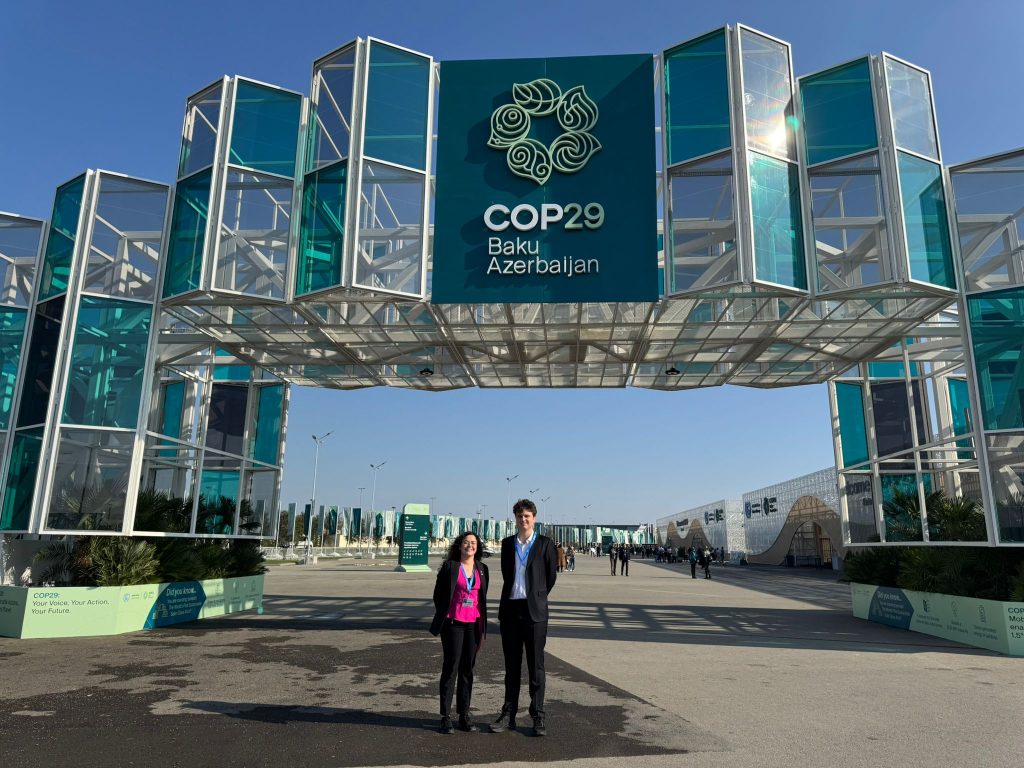
Written by Eme Dean-Lewis; PhD student with SCENARIO DTP.
In their annual Adaptation Gap report for 2024, published a few days before COP29, the United Nations Environment Programme (UNEP) calls for greater focus on adaptation project funding and outcomes for those most vulnerable to climate change impact. Adaptation in this context is the ‘process of adjustment to actual or expected climate and its effects’ (UNEP 2024). It means responding to climate change which has already happened, or which is already ‘baked in’ owing to greenhouse gases which have been released into the atmosphere until now.
The COP29 President outlined a vision for the 2024 conference in Baku with ‘two pillars’ (COP29 President 2024).The first is to set out ‘clear plans to keep 1.5 within reach’. This means limiting human-caused global warming to within 1.5 degrees Celsius above Earth’s ‘pre-industrial’ annual global temperature of 13.5°C (Copernicus Climate Change Service 2024a). Pre-industrial is defined as the average from 1850-1900. This vision drives focus on how to mitigate, i.e. reduce or prevent, the risk of future increases in global temperature. The threat of catastrophic consequences to all United Nations (UN) members from higher temperatures means available climate finance mostly flows to mitigation projects.
The rise in the number and severity of extreme weather events is a reminder that climate change is already affecting people’s lives and livelihoods. In recent times, we’ve seen hurricanes in the Caribbean, heatwaves in Europe and floods in Pakistan. Continued human-caused climate change impacts are expected, although mitigation projects to phase out fossil fuels can help bring it under control in the future.
Do natural variations in the Earth’s climate can explain recent dramatic weather? Scientists at the World Weather Attribution (2024) service assess if extreme weather events can be ‘attributed’, or linked, to human-caused climate change. From this and other research, we know that extreme weather events all over the world are already more likely to happen and more likely to be more damaging. Copernicus reports that for 2023, the average global temperature was 1.48°C above pre-industrial levels. That additional warmth means the Earth’s atmosphere can hold more moisture and so, for example, there will be more storms and they can carry more water to be ‘rained out’ later over land. We also know that global average sea level has risen 10.3cm in the last thirty years (Copernicus Climate Change Service 2024b). That is partly because ice sheets and glaciers are melting into oceans and creating more sea water. It’s also because the warmer sea water expands and therefore covers up more of the land.
Rising sea levels bring significant risk to coastal communities all over the planet. Imagine a community losing its farmland to rising sea levels—this is the reality adaptation funding can help change. Farming and other communities may need to strengthen sea defences or consider moving further inland. Such adaptation projects require funds. In some cases, sea level rise brings existential risk. The entire population of Kiribati, a Pacific island nation, may need to migrate to a new home (Allgood and McNamara 2017). Their low-lying country on the equator risks being submerged by the Pacific Ocean before the end of this century.
As extreme weather events grow more frequent and more severe, the need for urgent and robust adaptation projects becomes increasingly clear. While all countries need to deliver adaptation projects for their own populations, ‘Annex 2 countries’ (UNFCCC 2024a) contribute funding for developing nations. Annex 2 countries are twenty-five developed economies including Australia, the European Union, Japan, the UK and the US. The agreement for funds to flow from developed to developing countries, as defined by the UN, was enshrined in the Paris Agreement (UNFCCC 2015) and later when the global goal on adaptation (GGA) was launched (UNFCCC 2024b).
With the ambition to increase funding available to developing nations to address climate change, COP29 in Baku has been called the ‘finance COP’ (UNEP 2024). ‘Mobilising’ US$100 billion of climate finance per year by 2020 was agreed in 2010, at COP16, and achieved for the first time in 2022 (UNEP 2024). ‘Mobilised’ means that the funds are ‘made available’ to developing nations for agreed adaptation and mitigation projects. The funds are a mixture of grants and loans. Grants are gifts of money: they do not have to be paid back. Loans, however, must be repaid with interest. Many loans are at ‘concessional’, or lower, interest rates (CPI 2024) which means there is less, but still some, interest to pay. For developing nations who have existing high debt levels for other reasons, grants are the most helpful type of funding. UNEP (2024) reports that, apart from China, developing nations make annual interest payments which are higher than their adaptation funding needs. So they are increasing their national debt to invest in adaptation projects.
The funds mobilised by developed nations for developing nations are for both mitigation and adaptation projects and are mostly spent on the former. In 2022, of the overall US$116 billion (OECD 2024) mobilised, adaptation funding was less than a quarter at US$28 billion. That was a welcome increase of US$6 billion from the previous year, following a commitment made in Glasgow at COP26 (UNFCCC 2022) to double adaptation funding from 2019 levels by 2025. However, it is still less than 10% of the funds needed. UNEP reports that developing country adaptation financing requirement is $387 billion per year up to 2030 (UNEP 2024).
The second pillar of the COP29 President’s vision is to put in place ‘the means of implementation and support – finance, technology and capacity building’. The New Collective Quantified Goal (NCQG) is the key, hoped-for, finance deliverable to make significantly more funds available for adaptation and mitigation projects. Developing nations say they need $1.0-1.3 trillion per year for the next 10 years (Carbon Brief 2024). Discussions about committing a ‘quantum’, or amount, of new funds have stalled during the first week of COP29 (Earth Negotiation Bulletin 2024) but may progress in the second week. To deliver effective outcomes, funds need to come with a supporting package of enabling activities. This includes technology transfer, for example training in relevant technologies. Capacity building means increasing skills, knowledge and experience to expand the expertise and number of teams in a country able to plan, manage and successfully deliver the required adaptation and mitigation projects.
Well-researched climate science is necessary, but not sufficient, for a successful adaptation project. An additional consideration is the presence of transboundary effects. These arise where an adaptation project influences more than one country. For example, a water management project where a river flows across national border(s) and serves two or more countries. Professor Cornforth at the Walker Institute noted in her side-event at COP29 that ‘climate change impacts are transboundary in nature’. The Walker Institute has experience of building collaborative, multi-disciplinary teams to share best practice and address transboundary projects in Europe and the Middle East drawing on broad interdisciplinary knowledge (Cornforth 2024).
UNEP’s Adaptation Report 2024 (UNEP 2024) highlights the urgent need for a significant increase in adaptation finance being made available to developing nations. It looks to COP29 to ‘act ambitiously on adaptation finance’ and deliver a NCQG which ensures funds are allocated to adaptation projects, as well as those for mitigation. UNEP requests that funds are accompanied by resilient implementation plans to transfer technical knowledge and build skills capacity. The adaptation funding gap is huge while climate risks continue to grow. Lives and livelihoods depend on sustainable development in line with the GGA. At the mid-point of COP29, for country negotiators and ministers, there is much left to do. Reaching agreement on the NCQG is possible but not certain. The window to act is closing. If COP29 fails to prioritize adaptation funding, the world’s most vulnerable will bear the brunt of inaction. The time to step up is now.
References
Allgood, L., and K. E. McNamara, 2017: Climate-induced migration: Exploring local perspectives in Kiribati. Singap J Trop Geogr, 38, 370–385, https://doi.org/10.1111/SJTG.12202.
Carbon Brief, 2024: COP29: What is the ‘new collective quantified goal’ on climate finance? – Carbon Brief. https://www.carbonbrief.org/cop29-what-is-the-new-collective-quantified-goal-on-climate-finance/ (Accessed November 5, 2024).
COP29 President, 2024: Letter to Parties and Constituencies. https://cop29.az/en/presidency/letter-to-parties (Accessed November 5, 2024).
Copernicus Climate Change Service, 2024a: 2023 is the hottest year on record, with global temperatures close to the 1.5°C limit. https://climate.copernicus.eu/copernicus-2023-hottest-year-record (Accessed November 18, 2024).
——, 2024b: Sea level. https://climate.copernicus.eu/climate-indicators/sea-level (Accessed November 18, 2024).
Cornforth, R., 2024: Shared Risks, Shared Solutions: Addressing Transboundary Climate Risks Via Shared Adaptation Actions. Slides from COP29 side event 14Nov24,.
CPI, 2024: Understanding Global Concessional Climate Finance. https://www.climatepolicyinitiative.org/publication/understanding-global-concessional-climate-finance-2024/ (Accessed November 18, 2024).
Earth Negotiation Bulletin, 2024: Daily report for 16 November 2024. https://enb.iisd.org/baku-un-climate-change-conference-cop29-daily-report-16nov2024 (Accessed November 17, 2024).
OECD, 2024: Climate Finance and the USD 100 billion goal. https://www.oecd.org/en/topics/sub-issues/climate-finance-and-the-usd-100-billion-goal.html (Accessed November 18, 2024).
UNEP, 2024: Adaptation Gap Report 2024. https://www.unep.org/resources/adaptation-gap-report-2024 (Accessed November 17, 2024).
UNFCCC, 2015: Paris Agreement. https://unfccc.int/process-and-meetings/the-paris-agreement (Accessed November 18, 2024).
——, 2022: The Glasgow Climate Pact – Key Outcomes from COP26. https://unfccc.int/process-and-meetings/the-paris-agreement/the-glasgow-climate-pact-key-outcomes-from-cop26 (Accessed November 18, 2024).
——, 2024a: Annex 2 countries. https://unfccc.int/cop3/fccc/climate/annex2.htm (Accessed November 17, 2024).
——, 2024b: Global goal on adaptation. https://unfccc.int/topics/adaptation-and-resilience/workstreams/gga (Accessed November 18, 2024).
World Weather Attribution, 2024: Exploring the contribution of climate change to extreme weather events. https://www.worldweatherattribution.org/ (Accessed November 18, 2024).

